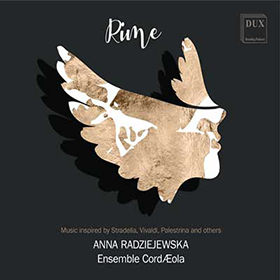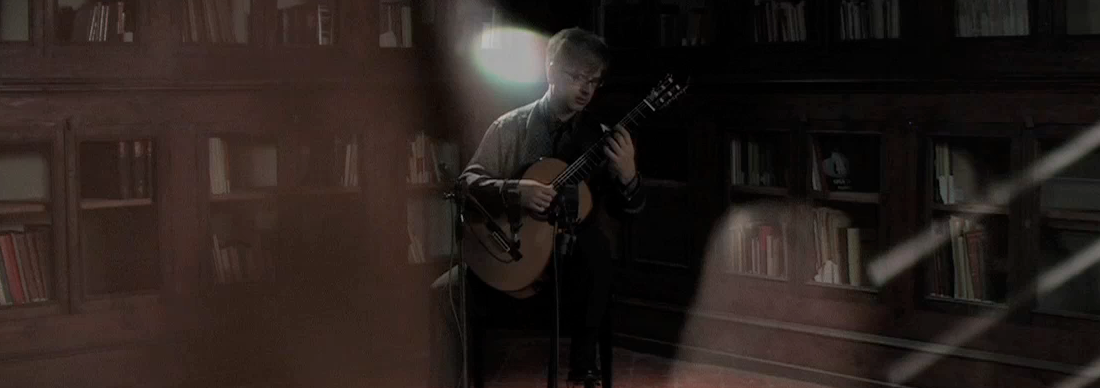RIME

Music inspired by Stradella, Vivaldi, Palestrina and others
ANNA RADZIEJEWSKA: soprano
Ensemble CordÆola:
Christoph Bösch, flutes;
Toshiko Sakakibara: clarinets;
Consuelo Giulianelli: harps;
Maurizio Grandinetti: guitars and electronics
DUX RECORDS
1. Preludio a „Sonno“: Maurizio Grandinetti
2. Sonno: A. Vivaldi/ M.Grandinetti
3. Canzonetta Spirituale: Ta. Merula/ M.Grandinetti
4. Chi viva Godendo: A- Stradella/ M.Grandinetti
5. Preludio a „Rime“: Maurizio Grandinetti
6. Rime: P. da Palestrina/ M.Grandinetti
7. Sento in seno: A. Vivaldi
8. Preludio a „Io per me“: Maurizio Grandinetti
9. Io per me non cangerei Alessandro Stradella
10. Col mio sangue: A.Stradella
11. Ma ch’è squallido e oscuro S. d’India
12. Su coronatemi A. Stradella
13. Preludio a „Caldo Sangue“: Maurizio Grandinetti
14. Caldo Sangue A. Scarlatti
http://en.dux.pl/grandinetti-rime-radziejewska-ensemble-cord-ola.html
In 1982 Nikolaus Harnoncourt wrote: “The music of the past has become a foreign language because of the progression of history, because of its remoteness from the present, and because it has been taken out of the context of its own period. Individual aspects of a piece of music may well be universally valid and timeless, but the message as such is linked to a particular time and can only be rediscovered when it is translated, as it were, into our contemporary idiom”.
The approach of this great Austrian musician was my initial inspiration to choose a new setting for this selection of Italian vocal Renaissance and Baroque music that was created in the city of Rome.
Nowadays, there is a unique musical genre, alternatively referred to as "transbaroque, re-imagined, or re-invented“, by which masterpieces of the past are reinterpreted by transpositioning ancient masterpieces into a more or less contemporary language.
In the case of "Rime", my intention is to regard the original music with my fullest expressive ability and intuitions, digging deep into the textual part. To do so, the vocal and text parts have been left almost completely intact but it has been layered with a new instrumental frame.
This project is the result of extensive efforts that led to the stage work “Engel der Verzweiflung” with Joachim Schlömer as theatrical director, and myself as musical director.
This work was intended as an afterthought of Angelus Novus by Walter Benjamin:
„... A Klee painting named Angelus Novus shows an angel looking as though he is about to move away from something he is fixedly contemplating. His eyes are staring, his mouth is open, his wings are spread. This is how one pictures the angel of history. His face is turned toward the past. Where we perceive a chain of events, he sees one single catastrophe which keeps piling wreckage upon wreckage and hurls it in front of his feet. The angel would like to stay, awaken the dead, and make whole what has been smashed. But a storm is blowing from Paradise; it has got caught in his wings with such violence that the angel can no longer close them. The storm irresistibly propels him into the future to which his back is turned, while the pile of debris before him grows skyward. This storm is what we call progress...“
Thanks to Benjamin's vision, this painting has, somehow, become the icon that represents the Angel of History. History seems crystalized and imprisoned by loads of tragedy and formidable events, inevitably pushed ahead by impetuous winds blowing from Heaven. Klee's fragile Angel cannot contrast these forces and survives, moving headlong in History and Progress.
Our Present is a very complex and, artistically speaking, bewildering time and it appears not to have clear directions. "Our" Angel seems rather held back, blocked by the forces that keep pushing, yanking him.
Does all this explain why in the field of musical interpretation, our interest is mainly focused on the past, searching for a long ago lost identity? Why is the behavior in the musical field so conceptually different than the restauration of plastic and figurative arts from the past?
The material of arts get altered through the centuries but its artistic contents are identified in our conscious perception in the very present. Each time we appraise art or listen to music, our actual surroundings set the landmarks for our artistic recognition. It is up to us to decide how „original“ the object needs to be, in order to recognize it.
Regarding Renaissance restorations, we know that Giovanni Angelo Montorsoli - one of Michelangelo's closest helpers -, worked on the Laocoon and on the Apollo statues at the Vatican Museums. In those days, restorers associated statues to the spirit of their own time, transposing them into a new language which conveyed the energy typical of their own epoch. The great art historian, Cesare Brandi, did not interpret Renaissance as the revival of ancient times, but as a transfiguration of universal concepts, part of a thoroughly new creative process.
Today we find Renaissance and pre-Baroque music attractive mostly because of what authors did not put in scores: the part assigned to improvisation and arrangement. From the beginning of the 1800s, the habit by which each composition only corresponded to one interpretation was assumed: the one faithful to the original. Nothing was left to arbitrary personal liberty.
What would happen to Occidental classical music if we tried to use a little Asiatic and African sensitivities, if we took into account 'immaterial', symbolic, ritual or religious values instead of dealing with its historic authenticity?
After all, the performance of each piece of ancient music is a celebration of the absence of the original, and of its author. We must decide whether to hide this absence or totally acknowledge it.
Rome.
„How many Pontiffs allowed ancient temples, statues, arches and other buildings in the universal homeland of all Christians to fall prey to ruin and spoliation? How many of them allowed the excavation of the foundations to get at some pozzolana, such that in a very short time those buildings collapsed? How much mortar was made from the statues and other ornaments of the ancients? ....This is something that gives me enormous grief—at the sight of what you could almost call the corpse of this great, noble city, once queen of the world, so cruelly butchered..... The destruction, however, is not entire—the framework survives almost intact, but without ornaments; you could almost describe this as the bones of a body without the flesh.“
Hereabove Raffaello is describing the eternal city as an icon of endless decadence - a death that lasts since thousands of years. That is how he spoke of Rome to Pope Leo X.
Today, when walking round Rome, it seems to us like a gigantic palimpsest where each cell stems from a dead one.
The music in this CD intends to resemble that type of organism: it may sometimes appear ill or merely rhetoric yet also bright and lively.
It seems that Rome almost needs an outward act of violence to clean up the air in its slowly decaying “boneless body”.
Raiders have assaulted Rome endlessly, yet the Renaissance town was utterly shocked by the Sack in 1539. It was transformed by the Counter-Reformation into an austere, penitent town. We recognize all these changes in Giovanni Pierluigi da Palestrina’s extraordinary music.
The suppression of profane works and of the last Sacred Representations (which were prohibited in 1539), induced an obsessive preference for novelties.
At the beginning, there were interludes; then gardens and fountains were accommodated; and later, finally the monumental Berninian and Borromean productions appeared.
In those conditions, also vocal music bloomed. The new religious brotherhoods, particularly the Jesuits, were trying to find new ways to enchannel people toward new religious participation by singing Lauds, and the Filippian congregations favoured the diffusion of musical Oratories in several Italian towns. This genre rapidly found fertile ground at court chapels and in aristocratic mansions. During the 17th century the most prestigious Italian dynasties: the De Medici, Borghese, Barberini, Pamphili, and Chigi families took turns at the head of the Roman Church. In a relatively short time, the city became a Baroque hyperbole - a theatrical town constantly representing itself.
Then a whirlwind brought in an educated, courageous, strong and excentric woman from afar. She dominated the culture circles and mondanity in town. After convertion and her consequent abdication, the former Luteran queen Christina from Sweden moved to Rome in 1655.
Her Royal Academy became the place for scholars to discuss around several different topics: from arts to music, from science to literature, from philosophy to religion. The most exclusive erudites primarily concerned in Classicism gathered round her.
Musicians such as Alessandro Scarlatti, Arcangelo Corelli and Bernardo Pasquini benefitted from the Queen's special protection. Thanks to her determined support, Tordinona, Rome's first public theater, was created.
Quite many masterpieces were written in those baroque mansions. They are, once again, being rediscovered by musical researches such as this project.
/div











